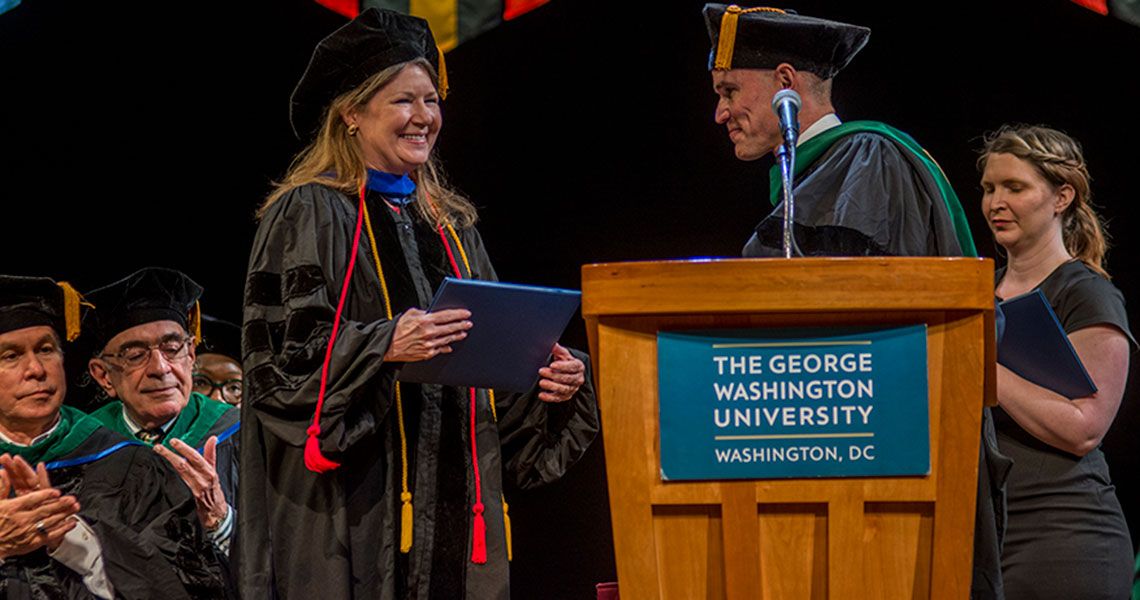At the M.D. graduation on May 21, Raymond Lucas, M.D., associate dean for faculty affairs and professional development at the George Washington University (GW) School of Medicine and Health Sciences (SMHS), announced 10 SMHS professors who have received Emeritus status.
“As the 11th oldest medical school in the United States, and the first in the nation’s capital, the George Washington University has a rich history of outstanding faculty accomplishments. Today, we honor several members of our faculty who are retiring from their academic positions after many decades of remarkable contributions to medical science, medical care, and medical education,” Lucas said.
The new Emeriti include:
Lawrence Thompson Bowles, M.D., Ph.D., Professor Emeritus of Surgery: Bowles joined the GW faculty in 1970 as clinical assistant professor in the Department of Surgery. In 1976, he became dean of SMHS and served in the role until 1988. He then was named vice president for medical affairs and executive dean of the GW Medical Center, a role in which he served until 1992. That year, he was named Honorary, Distinguished Professor of Surgery as well as president of the National Board of Medical Examiners. Bowles has remained involved as a member of the GW community through his service on committees and interviewing of medical school applicants.
Avital Cnaan, Ph.D., Professor Emeritus of Pediatrics: Cnaan began her tenure at GW in 2009 as a professor in the Department of Pediatrics. She has specialized in statistical analysis of research results from multi-center clinical trials. Cnaan also has served as director of the Coordinating Center of the Cooperative International Neuromuscular Research Group, a network of more than 20 clinical sites focusing on improving the quality of life of patients with neuromuscular diseases, and is an author on more than 150 peer-reviewed publications.
Raafat Hannallah, M.D., Professor Emeritus of Anesthesiology and Critical Medicine and of Pediatrics: Hannallah joined Children’s National Health System (Children’s National) and the GW faculty in the rank of professor in 1979. He has served GW’s educational and clinical programs as director of residency training and as chair of the Division of Anesthesiology at Children’s National. His service to the university includes serving multiple terms on the Medical Center Faculty Senate and chairing the Committee on Graduate Medical Education.
Sands Irani, M.D. ’68, RESD ’75, Clinical Professor Emeritus of Medicine: Irani received his M.D. from GW in 1968. After serving in the United States Navy Reserve, where he reached the rank of lieutenant, Irani completed a residency in internal medicine and a gastroenterology fellowship at GW. He then went into private practice in Chevy Chase, Maryland, and received an appointment to the faculty in the GW Department of Medicine in 1975. He served on the regular faculty for 16 years before being appointed to the clinical faculty in 2015. He was promoted to the rank of clinical professor in 2016.
Janette Krum, Ph.D. ’87, Associate Professor Emeritus of Anatomy and Regenerative Biology: Krum earned her Ph.D. in anatomy from GW in 1987. In 1991, she was appointed to the research faculty of the Department of Anatomy and Cell Biology. Krum then reached the rank of associate research professor in 1999 and was appointed associate professor of anatomy and regenerative biology and of neurological surgery in 2005.
Elena Nightingale, M.D., Ph.D., Adjunct Professor Emeritus of Pediatrics: Nightingale was appointed to the faculty as an adjunct professor in 1994 following a distinguished career at the Institute of Medicine (IOM) and the Carnegie Corporation and several years of service to the Children’s Research Institute of Children’s National. She is a member of the National Academy of Medicine (formerly the Institute of Medicine) and served as liaison or adviser on several IOM projects. She has also served on the Board of the Children’s Research Institute of Children’s National.
Raymond Scalettar, M.D., D.Sc., HON., Clinical Professor Emeritus of Medicine: In 1963, Scalettar was appointed to the faculty as a clinical assistant professor in the Department of Medicine. He was promoted to the rank of associate clinical professor in 1974 and the rank of clinical professor in 1980. During his practice, he served as chief of the Rheumatic Disease Section of Washington Hospital Center and the chief of rheumatology at Sibley Memorial Hospital. In addition, he provided key leadership in the development of the National Rehabilitation Hospital of Washington, D.C., and served as the first president of the hospital’s medical staff.
Hrant Semerjian, M.D., Clinical Professor Emeritus of Urology: Semerjian joined the clinical staff of GW Hospital and was appointed to the faculty as clinical professor of urology in 1976. He retired from the practice of medicine in 2016, but not before establishing himself as one of the leading urologists in the region. His career at SMHS was marked by achievements, including being the first fertility specialist for men in Washington, D.C., and participating in the first kidney transplant at GW Hospital.
Nalini Singh, M.D., Professor Emeritus of Pediatrics: Singh joined the clinical staff of Children’s National and was appointed to the faculty in the Department of Pediatrics in 1982. She was promoted to the rank of assistant professor in 1983, associate professor in 1988, and professor in 2000. Her contributions at Children’s National include serving as chief of the Division of Infectious Diseases for 12 years and contributing to the training of innumerable medical students, residents, and clinical fellows.
Raymond Walsh, Ph.D., Professor Emeritus of Anatomy and Regenerative Biology: Walsh joined the GW family in the Department of Anatomy and Cell Biology in 1978. He was promoted to the rank of associate professor in 1982 and the rank of professor in 1991. With colleagues in the School of Engineering and Applied Sciences, he co-founded the Laboratory for Advanced Computer Applications in Medicine, the predecessor of the GW Institute for Biomedical Engineering. Walsh also contributed to the development of his home department in his role as interim chair and chair for 17 years, and in the development of the neuroscience graduate program.



